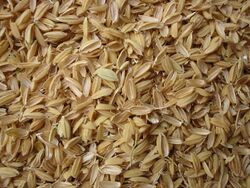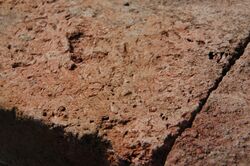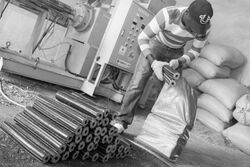Biology:Rice hulls

Rice hulls (or rice husks) are the hard protecting coverings of grains of rice. In addition to protecting rice during the growing season, rice hulls can be put to use as building material, fertilizer, insulation material, or fuel. Rice hulls are part of the chaff of the rice.
Production
Rice hulls are the coatings of seeds, or grains, of rice. The husk protects the seed during the growing season and is formed from hard materials, including opaline silica and lignin. The hull is hard to eat or swallow and mostly indigestible to humans because of its enriched fibre components. However, during times of food scarcity in ancient China, a common daily meal was a pastry made from rice husks, wild vegetables, and soybean powder. This led to the idiom "meals of cereal, hulls, and vegetables for half a year," indicating poverty and food insecurity.[citation needed]
Winnowing, used to separate the rice from hulls, is to put the whole rice into a pan and throw it into the air while the wind blows. The light hulls are blown away while the heavy rice fall back into the pan. Later pestles and a simple machine called a rice pounder were developed to remove hulls. In 1885 the modern rice hulling machine was invented in Brazil. During the milling processes, the hulls are removed from the raw grain to reveal whole brown rice, which is then usually milled further to remove the bran layer, resulting in white rice.
Uses

Ash
Combustion of rice hulls affords rice husk ash (acronym RHA). This ash is a potential source of amorphous reactive silica, which has a variety of applications in materials science. Most of the ash is used in the production of Portland cement.[1] When burnt completely, the ash can have a Blaine number of as much as 3,600 compared to the Blaine number of cement (between 2,800 and 3,000), meaning it is finer than cement. Silica is the basic component of sand, which is used with cement for plastering and concreting. This fine silica will provide a very compact concrete. The ash also is a very good thermal insulation material. The fineness of the ash also makes it a very good candidate for sealing fine cracks in civil structures, where it can penetrate deeper than the conventional cement sand mixture.
Rice husk ash has long been used in ceramic glazes in rice growing regions in the Far East, e.g. China and Japan.[2] Being about 95% silica, it is an easy way of introducing the necessary silica into the glaze, and the small particle size helps with an early melt of the glaze.
A number of possible uses for RHA include absorbents for oils and chemicals, soil ameliorants, a source of silicon, insulation powder in steel mills, as repellents in the form of "vinegar-tar" release agent in the ceramics industry, as an insulation material. More specialized applications include the use of this material as a catalyst support.[3]
Goodyear announced plans to use rice husk ash as a source for tire additive.[4][5]
Rice hulls are a low-cost material from which silicon carbide "whiskers" can be manufactured. The SiC whiskers are then used to reinforce ceramic cutting tools, increasing their strength tenfold.[6]
Toothpaste
In Kerala, India , charcoal from Rice husks (Umikari in Malayalam) were universally used for over centuries in cleaning teeth, before toothpaste replaced it.
Rice bran oil
Rice bran oil is the oil extracted from the hard outer brown layer of rice called chaff (rice husk). It is popular as a cooking oil in the Indian subcontinent and East Asian countries, including India, Nepal, Bangladesh, Indonesia, Japan, and Malaysia.
Brewing
Rice hulls can be used in brewing beer to increase the lautering ability of a mash. Rice husk is also used in one step of traditional preparation processes of Kaoliang (Sorghum) liquid. After fermentation, rice husk can be added into the wine tank to increase the void, which is advantageous for distillation.
Fertilizer and substrate
Rice hulls can be composted, but their high lignin content can make this a slow process. Sometimes earthworms are used to accelerate the process. Using vermicomposting techniques, hulls can be converted to fertilizer in about four months.
Rice hulls that are parboiled (PBH) are used as a substrate or medium for gardening, including certain hydrocultures. The hulls decay over time. Rice hulls allow drainage,[7] and retain less water than growstones.[8] It has been shown that rice hulls do not affect plant growth regulation.[7]
Fireworks
Rice hulls are coated with fine-grained gunpowder and used as the main bursting charge in aerial fireworks shells.
Fuel

With proper techniques, rice hulls can be burned and used to power steam engines. Some rice mills originally disposed of hulls in this way.[citation needed] Unfortunately the direct combustion of rice hulls produces large quantities of smoke. An alternative is gasification. Rice hulls are easily gasified in top-lit updraft gasifiers. The combustion of this rice hull gas produces a blue flame, and rice hull biochar makes a good soil amendment.[9]
Juice extraction
Rice hulls are used as a "press aid" to improve extraction efficiency of apple pressing.[10]
Pet food fiber
Rice hulls are an inexpensive byproduct of human food processing, serving as a source of fiber that is considered a filler ingredient in pet foods.[11]
Pillow stuffing
Rice hulls are used as pillow stuffing. The pillows are loosely stuffed and considered therapeutic as they retain the shape of the head.
Insulating material
Rice hulls themselves are a class A thermal insulating material because they are difficult to burn and less likely to allow moisture to propagate mold or fungi.[12] It is also used as roofing after mixing it with mud and water.
Particle boards and cardboard
Rice hulls are also used to make particle boards and cardboard. The silica in rice husk make the particle boards less attractive to termites.[13]
Geopolymers
Due to high amorphous silica content, the RHA (rice husk ash) can be used as a precursor material for geopolymer concrete.[14]
See also
- Rice-hull bagwall construction
- Winnowing barn
References
- ↑ Otto W. Flörke, et al. "Silica" in Ullmann's Encyclopedia of Industrial Chemistry, 2008, Weinheim: Wiley-VCH, . doi:10.1002/14356007.a23_583.pub3.
- ↑ Tichane, Robert (1998). Ash Glazes. Krause Publications. ISBN 0873416600. https://books.google.com/books?id=oPLh75SOqI0C&pg=PA34.
- ↑ J. Chumee et al. "Characterization of platinum–iron catalysts supported on MCM-41 synthesized with rice husk silica and their performance for phenol hydroxylation" Sci. Technol. Adv. Mater. 9 (2008) 015006 free download
- ↑ "Goodyear Converts Waste from Rice Harvest to Fuel-Efficient Tire Treads". http://www.goodyear.com/cfmx/web/corporate/media/news/story.cfm?a_id%3D1028.
- ↑ Goodyear Reaches Supply Agreements for Rice Husk Ash Silica (Online video) (YouTube). Goodyear Tire and Rubber Company. 2015-06-09. Retrieved 2016-05-26.
- ↑ "SiC Whisker-Reinforced Ceramic Composites". Materials Science and Technology Division - Physical Sciences Directorate. Oak Ridge, TN, USA: Oak Ridge National Laboratory. http://www.ms.ornl.gov/researchgroups/process/cpg/sic.htm.
- ↑ 7.0 7.1 Wallheimer, Brian (October 25, 2010). "Rice hulls a sustainable drainage option for greenhouse growers". Purdue University. http://www.purdue.edu/newsroom/research/2010/101025LopezHulls.html.
- ↑ "Growstones ideal alternative to perlite, parboiled rice hulls". (e) Science News. 2011-12-04. http://esciencenews.com/articles/2011/12/14/growstones.ideal.alternative.perlite.parboiled.rice.hulls.
- ↑ Olivier, Paul; Hyman, Todd (2012-03-27). "Biomass Gasification and the Benefits of Biochar". Engineering, Separation and Recycling LLC. http://esrla.com/pdf/landfill_06.pdf.
- ↑ Press aids
- ↑ "Ingredients to avoid". The Dog Food Project. http://www.dogfoodproject.com/index.php?page=badingredients.
- ↑ "Rice hulls in construction - Appropedia: The sustainability wiki". Appropedia. 2013-02-23. http://www.appropedia.org/Rice_hulls_in_construction.
- ↑ Coxworth, Ben. "Rice husks may find use in cheaper, greener, longer-lasting particleboard". GIZMAG PTY LTD 2017. https://newatlas.com/rice-husk-particleboard/37730/.
- ↑ Das, Shaswat Kumar; Mishra, Jyotirmoy; Singh, Saurabh Kumar; Mustakim, Syed Mohammed; Patel, Alok; Das, Sitansu Kumar; Behera, Umakanta (29 March 2020). "Characterization and utilization of rice husk ash (RHA) in fly ash – Blast furnace slag based geopolymer concrete for sustainable future". Materials Today: Proceedings. doi:10.1016/j.matpr.2020.02.870.
- Ma, Jian Feng; Kazunori Tamai; Naoki Yamaji; Namiki Mitani; Saeko Konishi; Maki Katsuhara; Masaji Ishiguro; Yoshiko Murata et al. (2006). "A silicon transporter in rice". Nature 440 (7084): 688–691. doi:10.1038/nature04590. PMID 16572174. Bibcode: 2006Natur.440..688M.
- Mitani, Namiki; Jian Feng Ma; Takashi Iwashita (2005). "Identification of the silicon form in xylem sap of rice (Oryza sativa L.)". Plant Cell Physiol. 46 (2): 279–283. doi:10.1093/pcp/pci018. PMID 15695469.
- Mitani, Namiki; Jian Feng Ma (2005). "Uptake system of silicon in different plant species". J. Exp. Bot. 56 (414): 1255–1261. doi:10.1093/jxb/eri121. PMID 15753109.
External links
- The Rice Hull House where rice hulls are used for insulation
- Uses for rice husk ash, or RHA
- Rice hulls used in cutting tool industry
